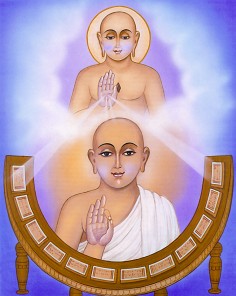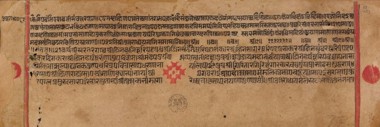Thirty-Fourth Lecture: On Lēsyā[1]
I shall deliver in due order the Lecture on Lēśyā; hear the nature of the six Lēśyās (produced by) Karman. (1)
Hear:
- the names,
- colours,
- tastes,
- smells,
- touches,
- degrees,
- character,
- variety,
- duration,
- result,
- life of the Lēśyās. (2)
-
They are named in the following order: black, blue, grey, red, yellow, and white. (3)
-
The black Lēśyā has the colour of a rain-cloud, a buffalos horn, (the fruit of) Riṣṭaka,[2] or the eye of the wagtail. (4)
-
The taste of the black Lēśyā is infinitely more bitter than that of Tumbaka,[10] (the fruit of the) Nimb-tree,[11] or of Rōhiṇī. (10)
-
The smell of the bad Lēśyās (viz. the three first) is infinitely worse than that of the corpse of a cow, dog, or snake. (16)
-
The touch of the bad Lēśyās is infinitely worse than that of a saw, the tongue of a cow, or leaf of the Teak tree. (18)
-
The degrees[16] of the Lēśyās are three, or nine, or twenty-seven, or eighty-one, or two hundred and forty-three. (20)
-
A man who acts on the impulse of the five āsravas,[17] does not possess the three Guptis, has not ceased to injure the six (kinds of living beings), commits cruel acts, is wicked and violent, is afraid of no consequences,[18] is mischievous and does not subdue his sensesa man of such habits develops the black Lēśyā. (21, 22)
A man of the following qualities: envy, anger, want of self-control, ignorance, deceit, want of modesty, greed, hatred, wickedness, carelessness, love of enjoyment; a man who pursues pleasures and does not abstain from sinful undertakings, who is wicked and violenta man of such habits develops the blue Lēśyā. (23, 24)
A man who is dishonest in words and acts, who is base, not upright, a dissembler and deceiver,[19] a heretic, a vile man, a talker of hurtful and sinful things, a thief, and full of jealousya man of such habits develops the grey Lēśyā. (25, 26)
A man who is humble, steadfast, free from deceit and inquisitiveness, well disciplined, restrained, attentive to his study and duties,[20] who loves the Law and keeps it, who is afraid of forbidden things and strives after the highest gooda man of such habits develops the red Lēśyā. (27, 28)
A man who has but little anger, pride, deceit, and greed, whose mind is at ease, who controls himself, who is attentive to his study and duties, who speaks but little, is calm, and subdues his sensesa man of such habits develops the yellow Lēśyā. (29, 30)
A man who abstains from constant thinking about his misery and about sinful deeds, but engages in meditation on the Law and truth only,[21] whose mind is at ease, who controls himself, who practises the Samitis and Guptis, whether he be still subject to passion or free from passion, is calm, and subdues his sensesa man of such habits develops the white Lēśyā. (31, 32)
-
There are as many varieties[22] of Lēśyās as there are Samayas[23] in the innumerable Avasarpiṇīs and Utsarpiṇīs, and as there are countless worlds. (33)
-
Half a muhūrta is the shortest, and thirty-three Sāgarōpamās plus one muhūrta is the longest duration of the black Lēśyā. (34)
-
The black, blue, and grey Lēśyās are the lowest Lēśyās; through them the soul is brought into miserable courses of life. (56)
-
In the first moment of these Lēśyās when they are joined (with the soul), the latter is not born into a new existence.[28] (58)
The blue Lēśyā has the colour of the blue Aśōka,[3] the tail of the Chaṣa,[4] or of lapis lazuli. (5)
The grey Lēśyā has the colour of the flower of Atasī,[5] the feathers of the Kōkila, or the collar of pigeons. (6)
The red Lēśyā has the colour of vermilion, the rising sun, or the bill of a parrot. (7)
The yellow Lēśyā has the colour of orpiment, turmeric, or the flowers of Śaṇa[6] and Asana.[7] (8)
The white Lēśyā has the colour of a conch-shell, the aṅka-stone,[8] Kunda-flowers,[9] flowing milk, silver, or a necklace of pearls. (9)
The taste of the blue Lēśyā is infinitely more pungent than Trikaṭuka[12] and Hastipippalī. (11)
The taste of grey Lēśyā is infinitely sourer than that of unripe Mango and Kapittha.[13] (12)
The taste of red Lēśyā is infinitely more pleasant than that of ripe Mango and Kapittha. (13)
The taste of yellow Lēśyā is infinitely better than that of excellent wine and various liquors, honey and Mairēyaka.[14] (14)
The taste of white Lēśyā is infinitely better than that of dates, grapes, milk, candied and pounded sugar. (15)
The smell of the three good Lēśyās is infinitely more pleasant than that of fragrant flowers and of perfumes when they are pounded. (17)
The touch of the three good Lēśyās is infinitely more pleasant than that of cotton, butter, or Śirīṣa-flowers.[15] (19)
Half a muhūrta is the shortest, and ten Sāgarōpamās plus one Palyōpamā and a part of an Asaṃkhyēya is the longest duration of the blue Lēśyā. (35)
Half a muhūrta is the shortest, and three Sāgarōpamās plus one Palyōpamā and a part of an Asaṃkhyēya is the longest duration of the grey Lēśyā. (36)
Half a muhūrta is the shortest, and two Sāgarōpamās plus one Palyōpamā and a part of an Asaṃkhyēya is the longest duration of the red Lēśyā. (37)
Half a muhūrta is the shortest, and ten Sāgarōpamās plus one muhūrta is the longest duration of the yellow Lēśyā. (38)
Half a muhūrta is the shortest, and thirty-three Sāgarōpamās plus one muhūrta is the longest duration of the white Lēśyā. (39)
I have described above the duration of the Lēśyās generally; I shall now detail their duration in the four walks of mundane existence.[24] (40)
The shortest duration of the grey Lēśyā (of a denizen of hell) is ten thousand years, the longest three Sāgarōpamās plus one Palyōpamā and part of an Asaṃkhyēya. (41)
The shortest duration of the blue Lēśyā (of a denizen of hell) is three Sāgarōpamās plus one Palyōpamā and a part of an Asaṃkhyēya, the longest ten Sāgarōpamās plus one Palyōpamā and a part of an Asaṃkhyēya. (42)
The shortest duration of the black Lēśyā (of a denizen of hell) is ten Sāgarōpamās plus one Palyōpamā and a part of an Asaṃkhyēya, the longest thirty-three Sāgarōpamās. (43)
I have described the duration of the Lēśyās of denizens of hell; I shall now describe that of animals, men, and gods. (44)
The duration of any of the Lēśyās except the best (viz. white one) is less than a muhūrta for (the lowest organisms), animals, and men.[25] (45)
Half a muhūrta is the shortest duration of the white Lēśyā (of animals and men), and the longest a Krore of former years[26] less nine years. (46)
I have described the duration of the Lēśyās of animals and men, I shall now describe that of the gods. (47)
The shortest duration of the black Lēśyā is ten thousand years, the longest a Palyōpamā and (a part of) an Asaṃkhyēya. (48)
The shortest duration of the blue Lēśyā is equal to the longest of the black one plus one Samaya; the longest is one Palyōpamā plus a (greater part of) an Asaṃkhyēya. (49)
The shortest duration of the grey Lēśyā is equal to the longest of the blue one plus one Samaya; the longest is one Palyōpamā plus (a still greater part of) an Asaṃkhyēya. (50)
I shall now describe the red Lēśyā as it is with gods, Bhavanapatis, Vyantaras, Jyōtiṣkas, and Vaimānikas. (51)
The shortest duration of the red Lēśyā is one Palyōpamā, the longest two Sāgarōpamās plus one Palyōpamā and a part of an Asaṃkhyēya.[27] (52)
The shortest duration of the red Lēśyā is ten thousand years, the longest two Sāgarōpamās plus one Palyōpamā and a part of an Asaṃkhyēya. (53)
The longest duration of the red Lēśyā plus one Samaya is equal to the shortest of the yellow Lēśyā; its longest, however, is ten muhūrtas longer. (54)
The longest duration of the yellow Lēśyā plus one Samaya is equal to the shortest of the white Lēśyā; the longest, however, is thirty-three muhūrtas longer. (55)
The red, yellow, and white Lēśyās are the good Lēśyās; through them the soul is brought into happy courses of life. (57)
In the last moment of all these Lēśyās when they are joined (with the soul), the latter is not born into a new existence. (59)
While the last muhūrta is running and a part of it is still to come, the souls with their Lēśyās developed, go to a new birth. (60)
A wise man should, therefore, know the nature of these Lēśyās; he should avoid the bad ones and obtain the good ones. (61)
Thus I say.
The lēśyās (adhyavasāya viśēṣāḥ) are different conditions produced in the soul by the influence of different Karman; they are therefore not dependent on the nature of the soul, but on the Karman which accompanies the soul, and are, as it were, the reflection of the Karman on the soul, as stated in the following verse from the Avachūri:
kṛṣṇādidravyasāchivyāt pariṇāmō ya ātmanaḥ |
spaṭikasyēva tatrāyaṃ lēśyāśabdaḥ pravartate ||
The alteration produced on the soul, just as on a crystal by the presence of black things, etc., is denoted by the word lēśyā. The Lēśyā, or, according to the above explanation, what produces Lēśyā, is a subtile substance accompanying the soul; to it are attributed the qualities described in this lecture.The word lēsā is derived from klēśa; this etymology appears rather fanciful, but I think it may be right. For the Lēśyās seem to be the Klēśas, which affect the soul, conceived as a kind of substance. The Sanskrit term Lēśyā is of course a hybrid word. It must, however, be stated that lēsā occurs also in the meaning "colour," e.g. Sūtrakṛt. I, 6, 13, and that the Prākṛt of klēsa is kilēśa.
Linum Usitatissimum, whose flowers are blue.The word for grey is kāū = kāpōta; in the comm., however, it is described as kiṃchit kṛṣṇā, kiṃchil lōhitā, which would be rather brown. But the description given in our verse leaves no doubt that grey colour is intended.
A kind of intoxicating drink, extracted from the blossoms of Lythrum Fructicosum, with sugar, etc.
The Lēśyās may possess their qualities in a low, middle, or high degree; each of these degrees is again threefold, viz. low, middle, and high. In this way the subdivision is carried on up to 243.
i.e. commits the five great sins.The following verses give the characterlakṣaṇaof the Lēśyās.
Literally: who avoids the ārta and raudra dhyānas, and practises the dharma and śukla dhyānas. These terms cannot be adequately translated; the reader may therefore be referred for details to Bhandarkars Report, p. 110 ff.
viz. as denizens of hell, brutes, men, and gods. Only the three first Lēśyās lead to being born in hell.
The consequence of this statement appears to be that at the expiration of the Lēśyā a new one is produced. The commentators, however, are not explicit on this head.
This verse seems to lay down the duration of the Lēśyā in the case of common gods, while the next one applies to Bhavanapatis, etc.
The question treated rather darkly in the next three verses is, according to the comm., the following:Every individual dies in the same Lēśyā in which he is born. When his Lēśyā ends with his life, then the soul must get a new Lēśyā. Our verses state at which time the new Lēśyā comes into existence or is joined with the soul.
 Ganadhar Sudharma Swami
Ganadhar Sudharma Swami
